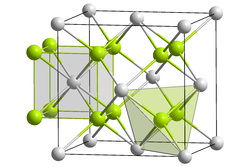Sodium oxide
| Crystal structure | ||||||||||||||||
|---|---|---|---|---|---|---|---|---|---|---|---|---|---|---|---|---|

|
||||||||||||||||
| __ Na + __ O 2− | ||||||||||||||||
| General | ||||||||||||||||
| Surname | Sodium oxide | |||||||||||||||
| other names |
|
|||||||||||||||
| Ratio formula | Na 2 O | |||||||||||||||
| Brief description |
White dust |
|||||||||||||||
| External identifiers / databases | ||||||||||||||||
|
||||||||||||||||
| properties | ||||||||||||||||
| Molar mass | 61.98 g mol −1 | |||||||||||||||
| Physical state |
firmly |
|||||||||||||||
| density |
2.27 g cm −3 |
|||||||||||||||
| Melting point |
1275 ° C ( sublimation ) |
|||||||||||||||
| solubility |
decomposes in water |
|||||||||||||||
| safety instructions | ||||||||||||||||
|
||||||||||||||||
| As far as possible and customary, SI units are used. Unless otherwise noted, the data given apply to standard conditions . | ||||||||||||||||
Sodium oxide is an oxide of sodium with the molecular formula Na 2 O.
Manufacturing
It can be obtained directly from the elements. In this case, however, it is necessary to observe the stoichiometry of the reaction and the temperature, since otherwise sodium peroxide and sodium hyperoxide are also formed if there is an excess of oxygen .
The reaction is carried out in a temperature range of 150-200 ° C. Higher temperatures encourage the formation of sodium peroxide.
Another possibility is the reaction of liquid sodium with sodium nitrate .
Pure sodium oxide can be obtained by reacting sodium azide with sodium nitrate.
The reaction of sodium hydroxide and sodium is also possible.
properties
It is a colorless solid that crystallizes in an antifluorite structure . Sodium oxide reacts violently with water to form sodium hydroxide
The standard enthalpy of formation of sodium oxide is ΔH f 0 = −418 kJ / mol.
use
Sodium oxide is used as etchant for the glass production, to polymerisation and as a desiccant used for drying organic solvents.
See also
Individual evidence
- ↑ a b c d Entry on sodium oxide in the GESTIS substance database of the IFA , accessed on January 9, 2019(JavaScript required) .
- ↑ a b c Entry on sodium oxides. In: Römpp Online . Georg Thieme Verlag, accessed on September 29, 2014.
- ↑ Data sheet Sodium oxide, 80% from Sigma-Aldrich , accessed on February 1, 2019 ( PDF ).
- ^ A b A. F. Holleman , E. Wiberg , N. Wiberg : Textbook of Inorganic Chemistry . 101st edition. Walter de Gruyter, Berlin 1995, ISBN 3-11-012641-9 , pp. 1173-1176.
- ↑ a b Georg Brauer (Ed.), With the collaboration of Marianne Baudler u a .: Handbook of Preparative Inorganic Chemistry. 3rd, revised edition. Volume II, Ferdinand Enke, Stuttgart 1978, ISBN 3-432-87813-3 , p. 951.





